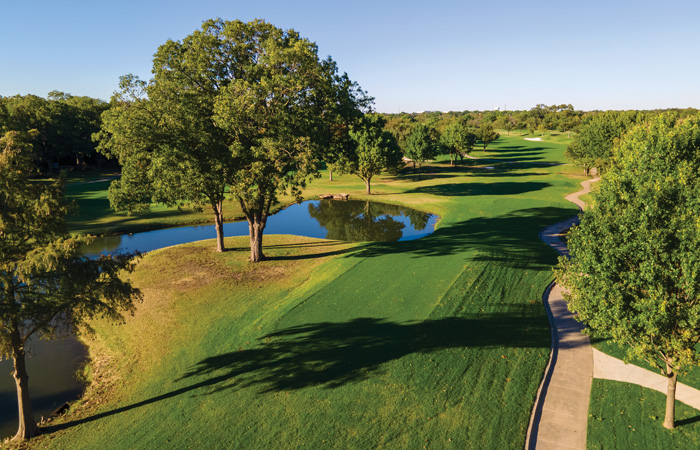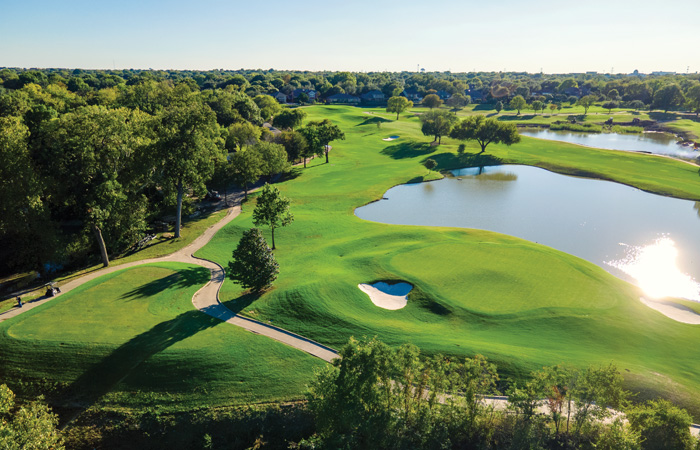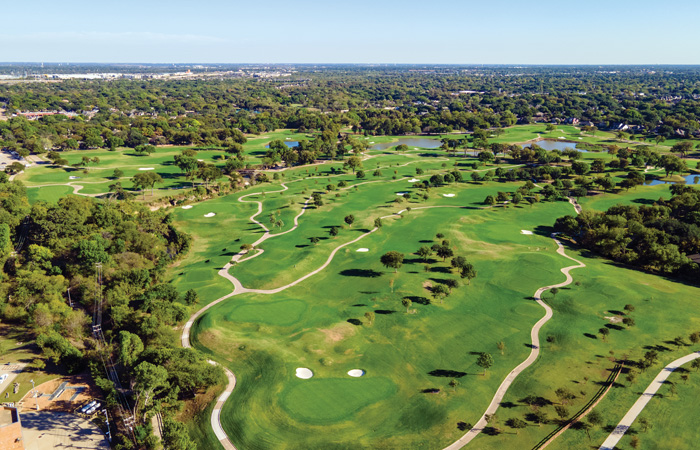Sherrill Park is municipal golf at its finest. Two courses, each offering a different challenge while maintaining solid conditions and playability for all skill levels. Sherrill Park No. 2 just underwent an extensive renovation of greens, tees and bunkers, as well as drainage improvements which will help conditions during the rainy spring months. The renovation gives this historic municipal a rejuvenated vibe, making a trip to Richardson well worth the effort.
For starters, Sherrill Park features a true muni-style clubhouse. There is some gear inside if you forget anything essential, and don’t forget to check out their GOAT-themed apparel with “The Ronny” Golf Park featured prominently to celebrate Ronny Glanton, who is the longtime pro at Sherril and one of the most important figures in Metroplex municipal golf.
The clubhouse grill offers your standard municipal track staples like burgers and dogs, but also has other items like chicken tenders or a delicious patty melt. It’s not super fancy, but the food is solid, and the dining area really offers that great city-owned course vibe that you remember from playing with your old man as a kiddo.

There is a driving range, chipping area and massive putting green, each of which you can use to dial in your game or get loosened up pre-round.
No. 2 opens with a tough little par 4 that requires a tee shot that carries Spring Creek, which meanders through the property. On a day where the wind is blowing from the south, this tee shot will play much longer, so be sure to choose appropriate tee boxes. Carry the creek and find the fairway, and players will be faced with nothing more than a short iron to a green that is very deep front to back. Pin placements set at the back of this putting surface can add a full club. It can be a tough opening hole, especially if the wind is blowing.
The second hole offers one of the major design changes from the old layout. A pond was removed to make the hole more user-friendly, and a waterfall was added to provide some visual appeal. The hole isn’t very long, playing around 350 yards from the tips, so longer hitters can be aggressive and look to put a scoring club in-hand, or choose to lay back and play for position.
No. 3 is a great elevated tee shot which offers a great look at the fairway below. Longer hitters can reach a small creek that crosses the fairway, so a three metal or hybrid might be the play off the tee. The green has some character, making even shots that find the center tough to two-putt.
The first par 3 of your round on No. 2 comes at the fourth. Playing at close to 190 from the tips, this hole offers a chance to chase the ball up to the green with something that lands short. Missing long here is a no-no, as the green falls off to an abyss of grass and awkward stances, making for a tough up-and-down.

The lone par 5 on the outward nine of this par-70 layout comes at No. 5. This tee shot trundles downhill and should favor the left side of the fairway for the best angle. Should you choose to go for the green, you will need to cover a creek that crosses about a hundred yards short of the green. It’s a gettable par 5 with a good tee shot and a great opportunity to gain a stroke before back-to-back par 4s that feature water.
The first of those par 4s is the sixth. This isn’t a long par 4, but water all down the left can be a deterrent from banging driver. Sure, you can hit the big dog, but depending on wind conditions and pin placement, a conservative approach with a long iron or hybrid might make more sense. A large bunker also guards the green on the front left, and over the back of the green is no cupcake either, so being precise with your approach is paramount.
No. 7 is another short par 4 flanked by water. Players can be aggressive, but the closer you get to the green, the more the fairway narrows. Hitting an iron or position would make the most sense here, as finding the fairway is very tough. More water must be carried short and right of the green, and over the back leaves a nasty chip, so be mindful of distance control on your approach.
After the short par-3 eighth hole, you come to the final par 4 of the opening nine. There isn’t much trouble off the tee to speak of, so those who want to grip and rip can swing away and try to make the hole as short as possible. Just be sure to favor the left side of the fairway for the best angle of approach.
No. 10 plays back downhill away from the clubhouse, and water on the right is in play for the longer players. A three metal or even hybrid is a smart play for position, and be sure to double-check the approach number as this massive green can leave players with a very long putt from front to back if irons aren’t precise.
The short par-4 11th hole is another look at Spring Creek, as it runs through the fairway. Big hitters can challenge carrying the creek, but the risk vs. reward is probably not worth it, so another conservative play is the best option. The elevated green is guarded by the creek on the left, so choosing a more conservative shot to the center of the putting surface is the best play, especially when there is a sucker pin on the left portion of the green.
The first par 3 on the back nine crosses back over the creek in the opposite direction. The narrow green can be hard to hold, so a high cut that lands softly is the best play should you have that shot in your bag. There is a bunker in front of the green that isn’t a bad miss if you feel you won’t be able to hold the green with a longer iron.

After a pair of short par 4s, players reach the longest hole on the course and the lone par 5 on then inward nine. This par 5 weaves back uphill and plays are a muscular 573 yards from the tips. Although it usually plays downwind, the gentle climb up the hill to the property line makes this feel like it plays longer than it does. A drive up the right center of the fairway is the best play, and even with a good tee shot and an extended flagstick, it can be tough to see the flag. There isn’t much trouble on the hole to speak of, it’s just long and requires brute strength to get there in two. It’s one of my personal favorites of the No. 2 layout.
A beautiful downhill par 3 comes next with a green flanked by a trio of bunkers. Pins on the left should be avoided, as two of those sand traps can collect balls short or long in that direction. If you want to go flag hunting, hope that the hole is cut in the middle of the green.
After another short par 4, the final hole at Sherrill Park No. 2 is a par 4 that plays back over the same creek you saw on No. 1. Use the bunker on the right as a good target line, and the grade of the fairway will work tee shots back to the middle. It’s a great view that climbs the hill back to the footprint of the clubhouse. It’s not horribly tough, so No. 18 offers one final chance at a birdie as you finish up your loop.
Sherrill Park is a great facility to loop 36. Have some breakfast, hit up one of their two courses, then lunch and play the other course in the afternoon. Now that No. 2 has reopened, I would suggest checking it out to see the new greens and some of the other sprucing up of this fun layout.

Sherrill Park has it all, including some of the nicest staff members anywhere in DFW. Glanton is one of our most beloved pros in the area, and he’s almost always there to greet players with a smile. There is a reason he was awarded the 2020 PGA of America Golf Professional of the Year.
Overall, if you live in the area or nearby, Sherrill Park is a no-brainer. Both courses are fun and enjoyable. If you aren’t near Richardson, be mindful of your tee time, as traffic can be a real bear getting in and out of the area depending on when you play. Given the pair of courses and overall value, Sherrill can get crowded, so be sure to have a plan when preparing to book your time.
Two courses and a great municipal vibe. Sherrill Park should be right in your wheelhouse.